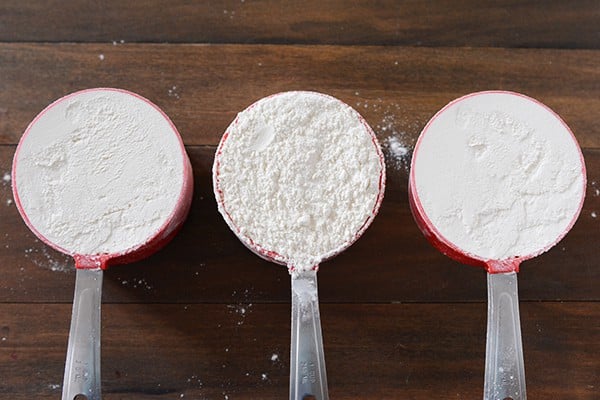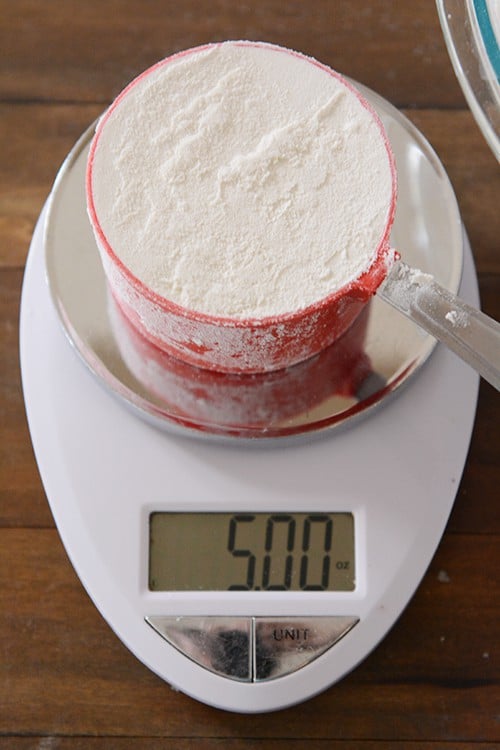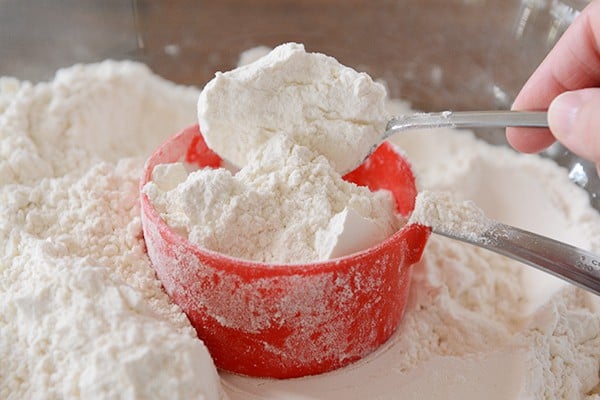Let’s Talk: How You Measure Flour Makes a Difference
How you measure flour makes all the difference in baked goods. Get all the details on the easiest, quickest way to measure flour correctly!

I hate to get all in your business today, but we need to talk about how you are measuring your flour.
Years ago, I did a kitchen tip about it. But it’s time for a little refresh (thanks for all your comments on the Triple Chocolate Zucchini Cookies this week that made me shoot this to the top of our Let’s Talk priority list).
If you asked ten people to measure out a cup of flour, it’s very likely that the actual amount of flour in each cup would be all across the board depending on how that person measured it. This is why many experts say the only real way to ensure baking success is to weigh your ingredients.
This is a great idea unless a) the recipe doesn’t give weights and b) you don’t own a digital scale. Don’t panic. Read on.
I’ve slowly been adding weight measures to my archived baking recipes (and most of my new posts over the last year include them). Seven years ago, you wouldn’t have seen me using a kitchen scale at all.
I thought it was fussy and a little pretentious, if I’m being honest, and unnecessary. But as I started baking more and more and more and reading advice from places I trust (like America’s Test Kitchen and King Arthur Flour), I decided it was worth $15 to get myself a digital scale (I’ve owned this one and currently own this one)…and I’ve never looked back.
Now. It gets a little confusing as many experts differ in what they recommend a cup of flour should weigh. For instance, King Arthur Flour says a cup of flour should weigh 4 ounces, and to my knowledge, that’s how they test their recipes. But when I weigh 4 ounces of flour, it looks like this:
…which is not even close to filling up the cup. To me, this says if you don’t own a scale, you are most likely going to significantly overmeasure the flour in a recipe that’s been developed using 4 ounces per cup.
America’s Test Kitchen, for most recipes, uses 5 ounces per cup. And because I can realistically measure out 5 ounces of flour in a cup, it’s the rule I follow.
It is safe to say that all the recipes on my blog that include weights have been developed using the 5 ounces per cup rule of thumb. If they don’t include weights, it’s still pretty safe to assume I’ve used 5 ounces per cup of flour since it’s how I consistently measure my flour (I’ll explain more below) even if I’m not weighing it.
Updated to add: there have been some questions in the comments, so let me clarify quickly – this post is intended to simply highlight how the method of measuring can impact the weight of a cup of flour. But on an every day, practical level, I don’t weigh my ingredients one cup of flour at a time like is shown in this post.
Instead, I put a bowl on the scale and use the tare feature to zero it out. Then I can add the dry ingredients until the correct weight is reached (using the tare function over and over if adding different dry ingredients to the same bowl).
If I had to whip up some scientific research from eight years of blogging and lots of troubleshooting with many of you in the comment thread of my baking recipes, I would go out on a limb and say that in many cases, flour is being over measured more than it is under measured.
Measuring flour probably falls into one of three methods (although clearly there could be more options if you got all wild and crazy with the flour measuring). Let’s take a look at them and see how each method converts to the scale. These three cups of flour were all measured differently although they look pretty similar. How do you think they stack up?
First up. The Dip & Level (or Scoop & Sweep or Dip & Sweep or…you get the picture) method. This is what I use 100% of the time when measuring flour with cups. Keep in mind: it assumes that the flour is nice and fluffy and not packed. I have an enormous flour bin in my pantry and I do this fluffing action every time before I measure out flour. Use a spoon or the measuring cup to break up the flour and fluff it up so it’s nice and airy.
Hello nice and fluffy flour.
Now, simply dip in the cup lightly without overpacking the flour.
And level it off with a straight edge.
Ah, look at that. Five ounces on the money. That’s what I’m after with every cup of flour that I scoop.
Another common method is to Dip & Shake (or Scoop & Shake) and even though it sounds like a funky, old school dance, it’s actually the flour measuring method you should never, ever use. Here’s why.
After you dip in the cup to measure the flour…
…and it’s piled high…
…you might be tempted to take the easy way out (you know, no dirtying an extra knife and all) and shake it down to level.
But it doesn’t take a rocket scientist to figure out that by doing this, more flour is getting compressed into the cup. In this case, over 1/2 an ounce more flour is in this cup than in the Dip & Level method.
Half an ounce can make a huge (massive, earth shattering) difference in a recipe, especially if it calls for more than one cup of flour. This cup of flour was used with the aforementioned fluffy flour. It would weigh even more if that cup had been scooped into dense, compacted flour. I’m shivering with dread just thinking about it.
The last method to highlight is the Spoon & Level way. My grandma measured her flour this way. Spoon it in.
Level it off. And call it good.
And while it’s a great way to avoid packing too much flour into the cup, you may end up with a notoriously light cup of flour. 4.6 ounces in this case – almost half an ounce the other direction.
Here it is in one glance.
So what does all of this mean?
For me and my blog, it means if you want the very best results from the baking recipes (see a note below about breads, specifically) compiled here, use the dip and level method (if you aren’t already). It’s how I measure flour and the recipes here will be consistent with that method.
Even better, if the recipe uses weights, pull out your kitchen scale (or add it to your wish list!) and use that instead. Just to test it out, if you don’t use a kitchen scale on a regular basis, try borrowing one from a friend or neighbor to quickly see how much a cup of flour you measure weighs. If anything, it will give you a guideline on whether or not to start measuring differently or how to adjust your measuring technique for recipes you are using.
Updated to add: in this post I am highlighting an individual cup of flour and how much it weighs but if you are new to using a kitchen scale or just curious, on an every day practical level, when I’m baking, I don’t measure each cup of flour for a recipe one-by-one like this. I usually place a bowl on the scale, use the tare feature to zero it out, and then add the dry ingredients to the bowl until it gets to the desired weight (this goes for flour, sugar, oats, cocoa, and on and on). If you are adding several different dry ingredients to the same bowl, you can keep using the tare function to add the ingredients together, zero-ing it out everytime to get accurate weights for each ingredient (this will save you from using lots of separate bowls so you feel like using a scale is actually productive and efficient).
When I use recipes from other sources and weight measures are not included, I always stick to my dip & level method. That’s not to say the recipes turn out 100% of the time (ha!) but unless I know the recipe has been tested using a different method, it’s just what I do. You could always email the blogger/source and ask them how they measure their flour so you can try doing the same when using their recipes.
Too much flour can lead to dense cakes and breads, cookies that don’t flatten at all, and a lot of other problems. Not enough flour could mean gummy or spongy cakes, bread that falls and pancake-thin cookies, among other things.
Updated to add: remember (all my lectures over the years about this should be somewhere present in your mind) that when it comes to yeast breads and rolls and other doughs, I almost never use a specific volume or even weight of flour – based on a million different factors, I go by the texture and feel of the dough. Bread making is it’s own separate animal. The flour info in this post is most appropriate for technical baking like cookies, cakes, brownies, quick breads, muffins, etc.
Because I want you to be a complete rock star in the kitchen (and to kill it with the recipes I have posted here), I wanted to clarify how I measure flour (and I don’t want to sound bossy, but how I think you should measure flour, too).
And. I think that is all.
Who knew I could wax so long and poetic about measuring flour.
And if you are interested in appeasing my curiosity, how do you measure your flour?
As always, this post is unsponsored; I’ve included a few affiliate links in the post above to the kitchen scales I highly recommend and use on Amazon.



















I use the do and level method. When they give weights, it confuses me.
However i recently got a scale, so I will make sure I’m using correct amount of flour. I knew how to use the tare thing, but I didn’t know I could keep zeroing it out like you explained. This has been most helpful for me! Thank you!
The consensus on flour is 130 grams equal 1 cup for unbleached all purpose. 236 grams for water and 242 grams for milk. How I came up with the measurements is; I googled them. There were varying opinions so what I did was I went with the amount that appeared the most and was the most reliable source. No matter I’ve adjusted all of my recipes using the Bakers Percentage which is your flour is 100% and the rest of the ingredients are a percentage of the flour. If you weigh out all of your ingredients in grams it’s easy to adjust all of your ingredients
I have been baking for a long time and purchased a kitchen scale a few years ago. The weighing of the flour provides consistent results, in your baked items. I use King Arthur Flour and their recommended weight, on their package is 120 grams per one cup.
However, I spoke to a bakery owner and their recommended weight is 140 grams per cup.
The scale is very helpful when making bread!! Im using the 140 grams per cup now……
Great information, thank you! I DID see/hear/read the dip and level was the proper way several years ago, but it was a real revelation to me. I’ve never been a great baker so I’ve never done much of it. But my family all tend toward being heavy and don’t NEED baked goods often. THen I was hit with being gluten-intolerant 15 yrs ago. That pretty much put an end to any baking I was attempting. With the evolution of available gf flours and products, I’m more interested in trying a few things. I like your suggestion of the scale. I had also read years ago that was fairly necessary but at the time it struck me as way too fru-fru and only for REAL bakers, which I was barely at all. It’s now on my Wishlist.
Thank you! This explains a lot. My cookies are always flat. Thanks for posting. I’ve got a scale, time to pull it out. BTW, I’m a “lightly spoon and level” kind of gal. That’s what I remember from Home Ec. in the Summer of ‘72.
MELS: Re flour measuring
I use a small 2 inch sifter and scoop out flour in it. I shake the flour into the measuring cup and just use the bottom of the sifter to roughly level the flour in the cup.
I check the dough ball while making the dough and add water or flour to get a soft and just slightly tacky dough.
Works for me
Tom E
BIG FAN
I was taught to always sift my flour before measuring. Is this considered fluffing . Should I wait until after sifting to add my other ingredients. Your help greatly appreciated.
Sifting will produce a finer/lighter result than fluffing.
Thanks for the article on measuring flour. Even though I had Home Ec in school, I didn’t feel confident about it! I also worry about when my flour should be sifted or not. What’s the rule on that? Thanks!
I use your way of measuring flour; I use my Bosch Universal Plus Mixer, same bench scraper as you and same bread knife as you without having know you use them when I got them!!
Question: Since KAF recipes are based on 1 cup=4oz, while others such as Cook’s Illustrated are based on Gold Medal Flour, with 1 cup=5 oz, if one wants to make the Cooks Illustrated recipe and only has KAF flour, do you recommend using the 10 oz called for in the recipe based on Gold Medal?
In other words, when substituting flour is it the volume or the weight that is important?
Such a good question, Rosemarie. My advice is to use the measurements in the recipe you are using since it’s been tested that way. I don’t think it’s an issue of the type or brand of flour, it’s more an issue of how the recipe has been tested. For instance, I follow 1 cup = 5 ounces. But if I’m making a recipe from King Arthur Flour, no matter the brand of flour I use, I use their 4 ounce per cup measurement. If a recipe doesn’t give ANY weight measures, I fluff the flour, scoop lightly and level off (and don’t use weight measures at all). If you are making a Cook’s Illustrated recipe with King Arthur Flour I would use Cook’s Illustrated’s 1 cup = 5 ounces measurement since that’s how the recipe has been tested. Does that help?
I do dip and level but did not realize that I needed to fluff before measuring! Amazon loves you—- I ordered my kitchen scale!
Im ordering a scale and will try baking with it. Using a scale, how will this effect my liquid ingredients? My measuring cups are 8oz. Measures.
I’m making your sandwich bread now.
Different flours will weigh different, look on the side of the package for the manufacturer’s numbers for each flour as to how many grams are in a cup. As a side note measuring grams it’s way more accurate. King Arthur unbleached white flour is 120 grams per cup.
For cakes, breads and baked goods, I always do either the spoon in an level, or better yet, just weighing it out. I lean towards the 4 1/4 oz per cup, unless the recipe says sifted. Most of my cookbooks for cakes and breads have the weight equivalent of 4.25 oz. I’ll make sure to use a full 5 ounces with recipes from this website!
Hi Mel! Do you use bread flour at all? Or would you say most, if not at all, of your recipes call for all-purpose flour? I just noticed that your French bread rolls call for all-purpose four and I’ve been using bread flour. Thanks!
Hi Marcie – I don’t usually keep bread flour on hand, so I almost always use unbleached, all-purpose flour and if I want bread flour, I’ll add in a couple tablespoons of gluten (since I always have that on hand for whole wheat bread making). However, bread flour will sub really well for the French bread roll recipe and a few other bread recipes on my site (like the French bread). It adds a bit more chewiness.
Thank you for the info. I guess the recipe I have must mean that she uses more flour by packing it down so that the cookies don’t flatten. Will save your blog . Shirley
My mom always did the spoon and level method but I usually just shake it down. Oops!
I did notice while in Australia, a lot of recipes are in grams which is really nice because it makes it super easy to weigh ingredients. I wish more recipes were in weight because it can make a big difference!
My baking has changed for the better since I started using a scale to measure ingredients! I do not do it for everything I cook but now I always use it for cookies, cakes, and breads!